Key takeaways:
- Open communication is essential for blended families, fostering understanding and trust among members.
- Establishing rituals and family bonding activities can create connections and a sense of identity.
- Effective conflict resolution strategies, such as active listening and providing cooling-off periods, are crucial for healthy family dynamics.
- Celebrating individual uniqueness within the family enhances relationships and strengthens bonds.
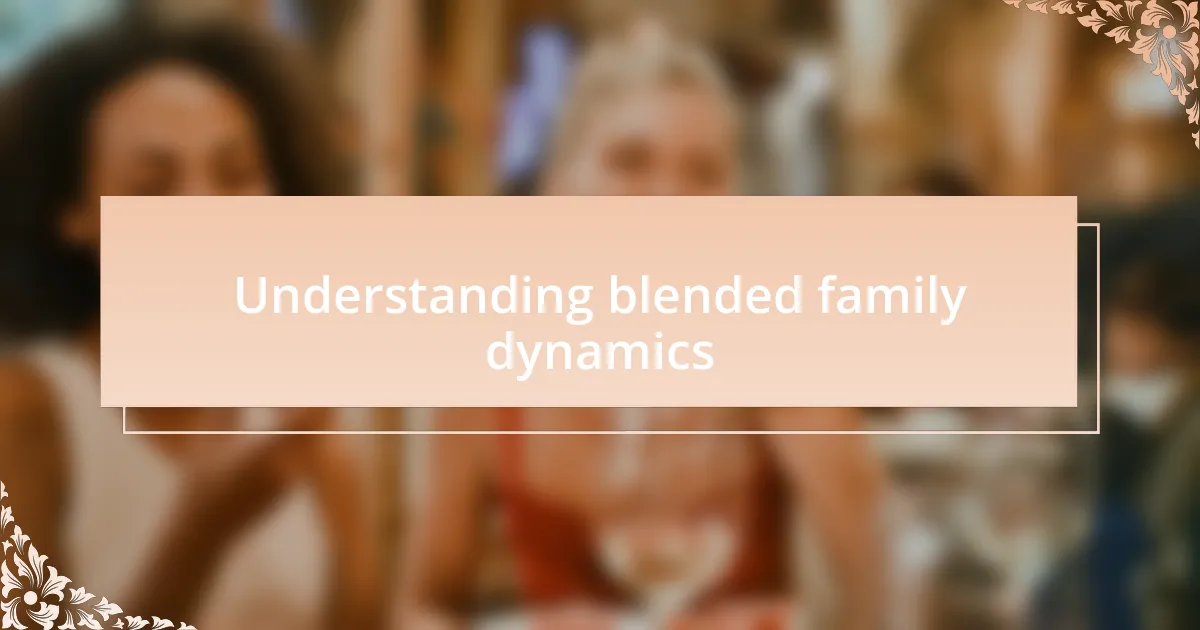
Understanding blended family dynamics
Blended family dynamics can be complex, often influenced by the history and emotional baggage each member brings into the new family unit. I remember a time when my friend’s children would act out, testing boundaries not just with their new step-sibling but also with their parents. It made me realize that these behaviors are often manifestations of deeper feelings like insecurity or fear of being replaced.
Communication is crucial in navigating these dynamics. Have you ever watched a family member struggle to voice their feelings? I’ve seen how open dialogues can create understanding, like when my cousin encouraged his teenage stepdaughter to share her struggle of balancing her loyalty to her biological parent while embracing her new family. It was a turning point that fostered unity, underscoring how important it is to create a safe space for each member to express their emotions.
Another important aspect is the role of rituals in blended families. I recall participating in a family dinner that blended traditions from both sides, creating a unique experience that everyone could enjoy. These simple acts allow families to form a new identity together and bridge gaps, turning what might feel like a obligatory gathering into a cherished moment of togetherness. It’s the small things that often lead to deeper connections, don’t you think?
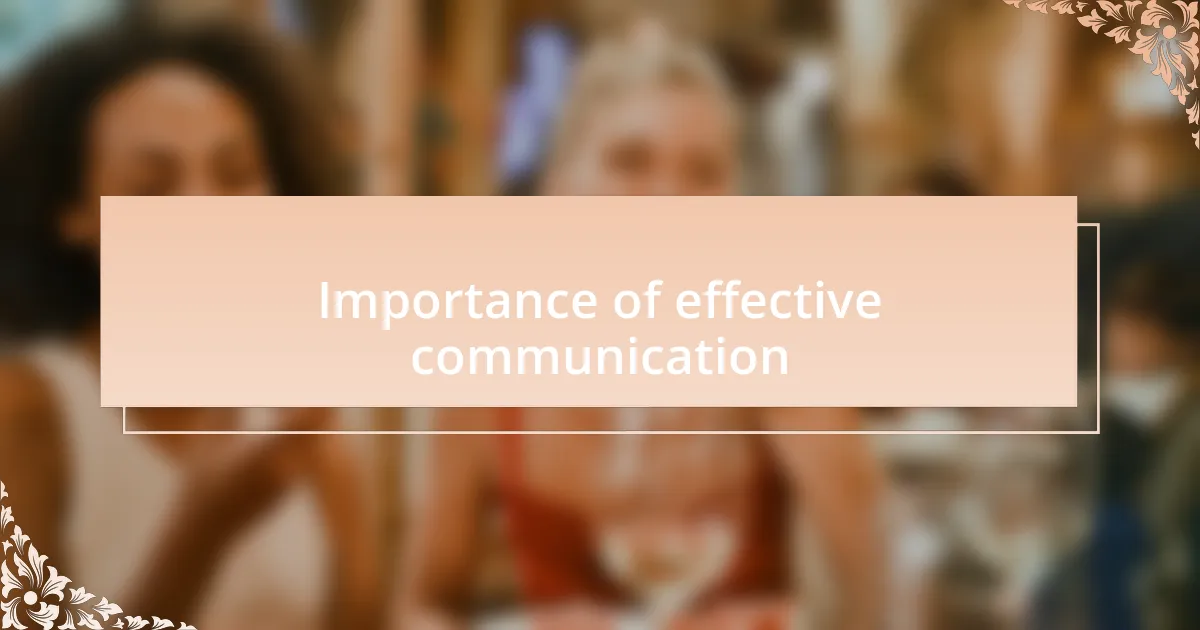
Importance of effective communication
Effective communication serves as the backbone of any blended family dynamic. I remember a conversation at a brunch where one of my friends candidly shared how his family tackled misunderstandings. His openness created a ripple effect, encouraging others to share their challenges. It became clear that discussing feelings—not just issues—allowed everyone to feel valued and understood.
In another instance, I witnessed a blended family navigate a delicate situation during a weekend outing. Rather than avoiding conflict, they openly discussed parenting styles and boundaries in an informal setting. That genuine exchange not only diffused tension but also strengthened their bonds, illustrating how proactive communication can transform obstacles into opportunities for growth.
Ultimately, when family members feel safe to articulate their thoughts and emotions, it nurtures an environment of trust. I often think about a time when my sister’s family faced tension during holiday gatherings. By establishing a routine of sharing feelings before meals, they cultivated an atmosphere where everyone’s voice mattered. Isn’t it fascinating how a few honest conversations can lay the groundwork for lasting connections?
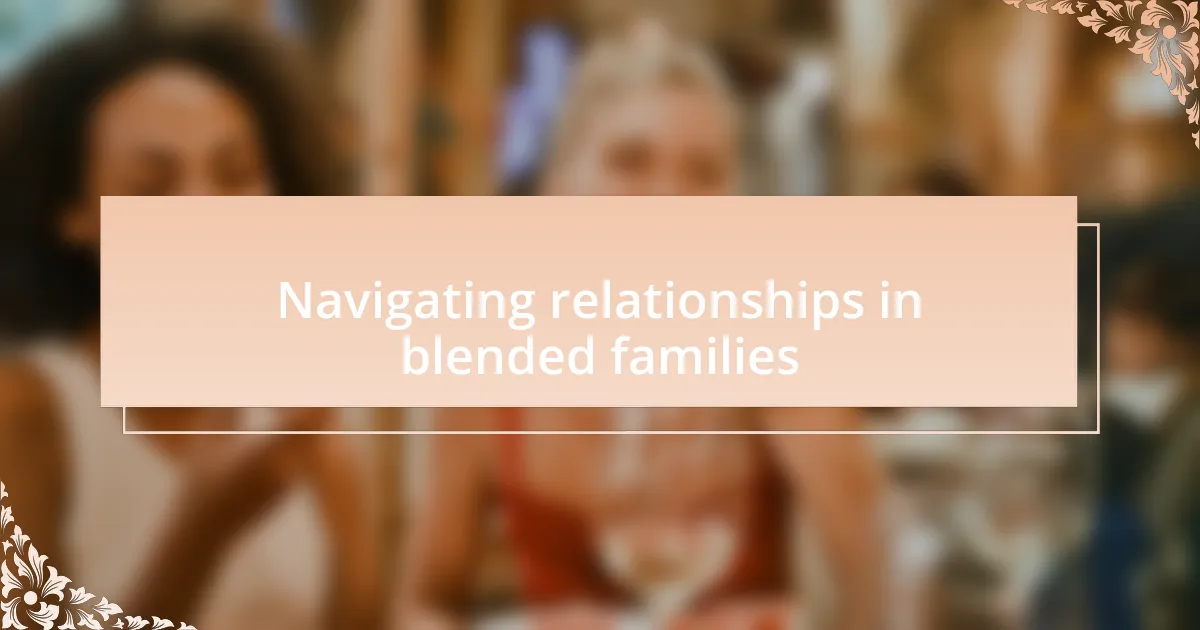
Navigating relationships in blended families
Navigating relationships in blended families can often feel like walking a tightrope. I recall a moment at a family gathering when my stepson and I found ourselves awkwardly circling around an unresolved issue. It hit me then that instead of pretending everything was fine, we could approach our differences with curiosity rather than defensiveness. Don’t you think that approach could foster better understanding and empathy between family members?
In another experience, I observed how rituals can bring a sense of stability and familiarity to new family dynamics. During a weekly brunch, my partner’s kids and I decided to share what we appreciated about each other. This simple yet heartfelt exchange transformed our interactions from distant to genuinely connected. It struck me how small traditions, such as taking time to express gratitude, can build a safety net that catches us when the emotional winds get turbulent.
Establishing boundaries is crucial too. I remember when my partner and I set some ground rules on parenting styles after an incident involving the kids. It wasn’t easy, but that clarity allowed us to approach challenges collaboratively rather than competitively. Isn’t it empowering to know that, as blended families, we can redefine roles and expectations, creating a supportive network that benefits everyone?
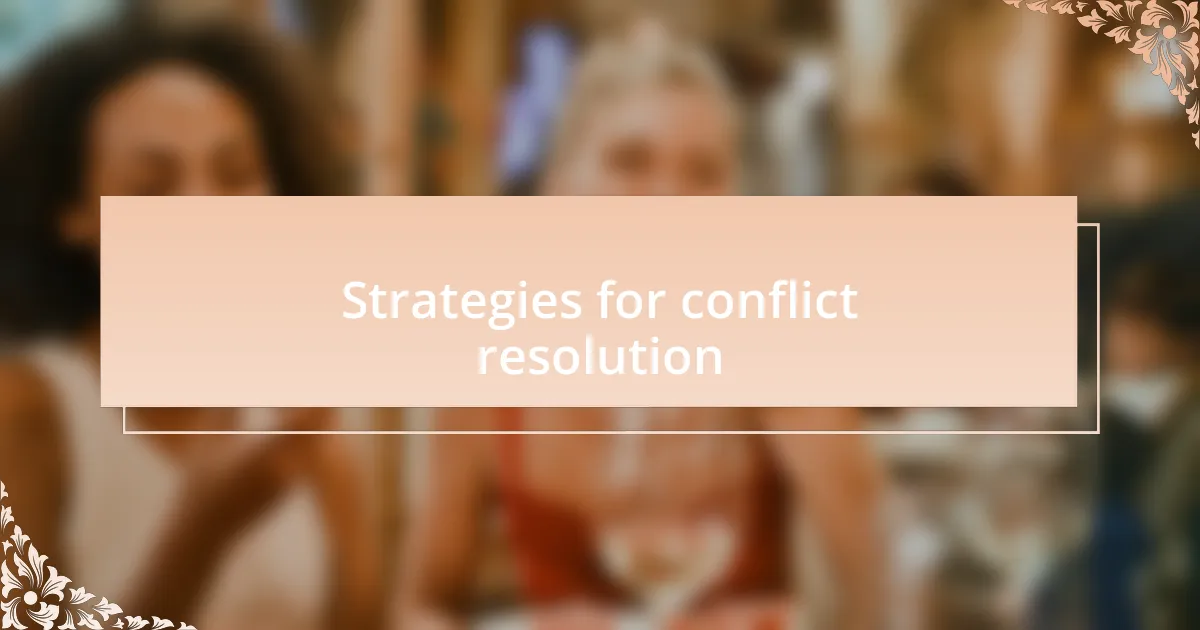
Strategies for conflict resolution
Finding effective ways to resolve conflicts makes all the difference in blended families. I recall an intense disagreement between my partner’s daughter and my son over a shared gaming console. Instead of letting that escalate, we gathered everyone for a “family council” where each voice mattered. It was incredible to see how openly discussing feelings not only diffused the tension but also strengthened their bond. Have you ever tried an open forum to resolve conflicts?
Active listening is another powerful strategy I’ve found essential. Once, during a heated moment over holiday plans, I made sure to paraphrase what my stepson expressed, showing him I truly understood his concerns. I noticed how my validation opened the doors for him to share more and, ultimately, reach a compromise. Do you think allowing each family member to feel heard can shift perspectives in tough situations?
Lastly, encouraging a “cool-off” period can prove beneficial. I learned this after a particularly charged discussion about house rules, where everyone left feeling frustrated. We decided to take a breather, and when we came back together, everyone brought clearer minds and fresh perspectives. It was enlightening to realize that sometimes, stepping away can pave the way for resolution. Have you experienced how a moment of reflection can reshape discussions?
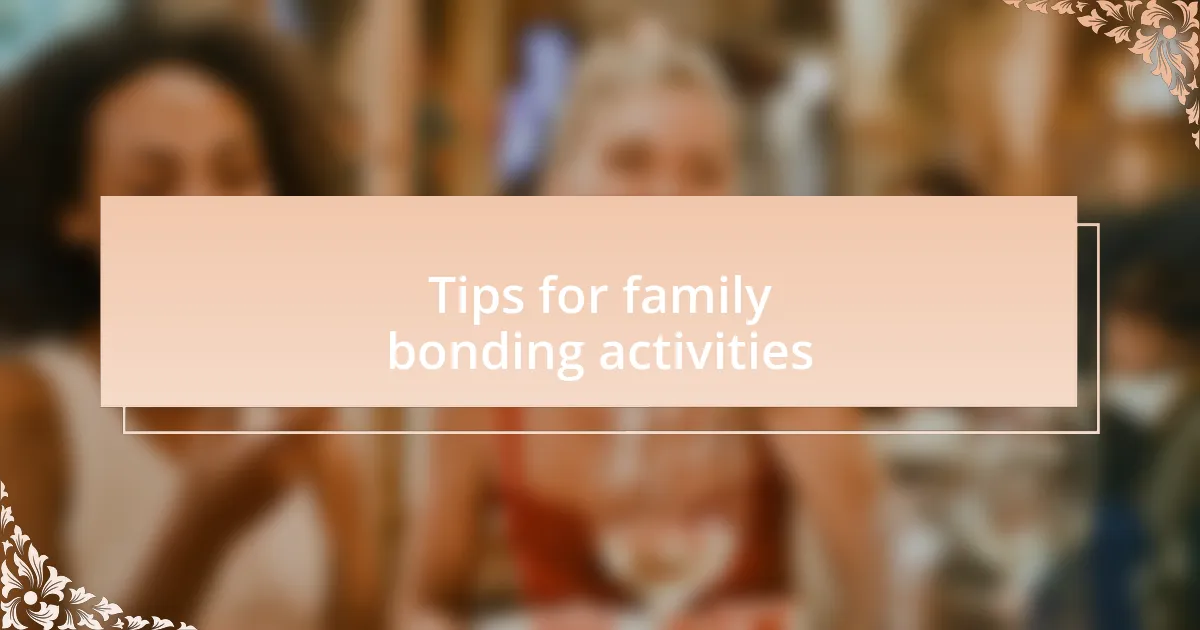
Tips for family bonding activities
Engaging in family bonding activities can truly transform blended family dynamics. One of my favorite experiences was organizing a weekly game night. It’s not just about competition; it’s about laughter and collaboration. Each week, we picked a new game, which sparked conversations and allowed everyone’s personality to shine. Are there games that have brought your own family closer together?
Cooking together has also been a rewarding way to connect. I remember one Saturday when we decided to tackle homemade pizza. The kitchen was a whirlwind of flour, toppings, and laughter. Everyone had their own unique way of creating their pizza masterpiece. This not only fostered teamwork but also generated fun memories that we’ll cherish for years. What meals have you enjoyed preparing as a family?
Outdoor adventures can provide that extra layer of bonding too. I took my blended family on a hiking trip, and as we navigated the trails, we shared stories, dreams, and even fears. It was during a particularly steep climb that I noticed how working together encouraged support and encouragement among us. Have you tried exploring nature as a way to deepen family connections?
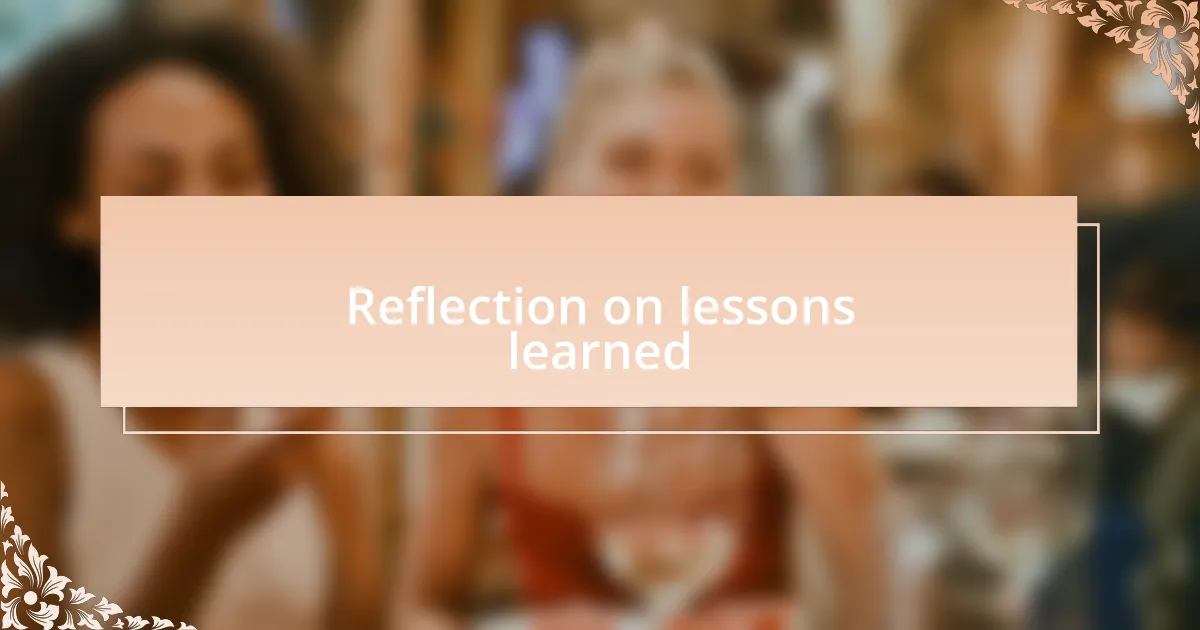
Reflection on lessons learned
Reflecting on the lessons learned in a blended family, I realize how crucial patience truly is. I remember a moment when we celebrated our first holiday together. Expectations ran high, yet the reality was filled with small misunderstandings. Instead of frustration, I learned to embrace the chaos and let patience guide my reactions. How many times have you had to remind yourself to slow down in similar situations?
Another lesson that stands out is the power of open communication. There was a time when one of the kids felt unheard during family discussions. It struck me how vital it is to create an environment where everyone feels valued. By actively listening, we paved the way for more honesty and sharing among us. Have you ever tried to encourage open dialogue in your own family?
Lastly, I’ve learned to celebrate individual uniqueness. One particular experience that touched my heart was when we organized a “show and tell” for our family night. Each child shared something personal, and it highlighted their distinct interests and talents. This taught me that while we may be different, our diversity enriches our family bond. How do you honor the individuality of each family member?